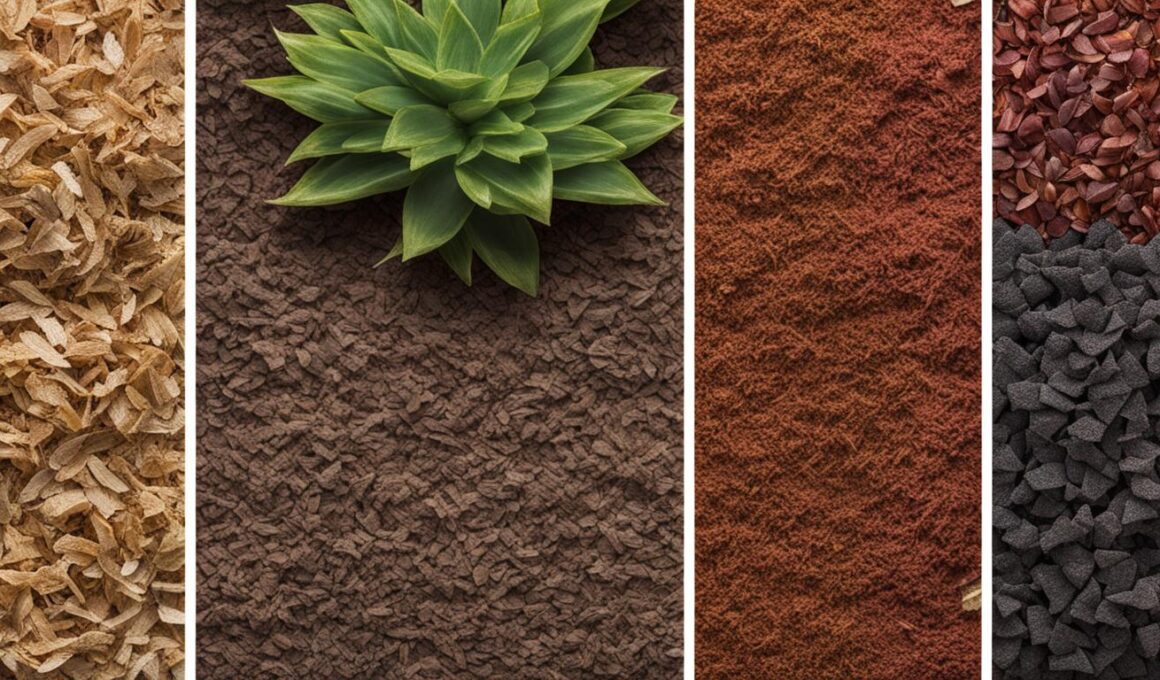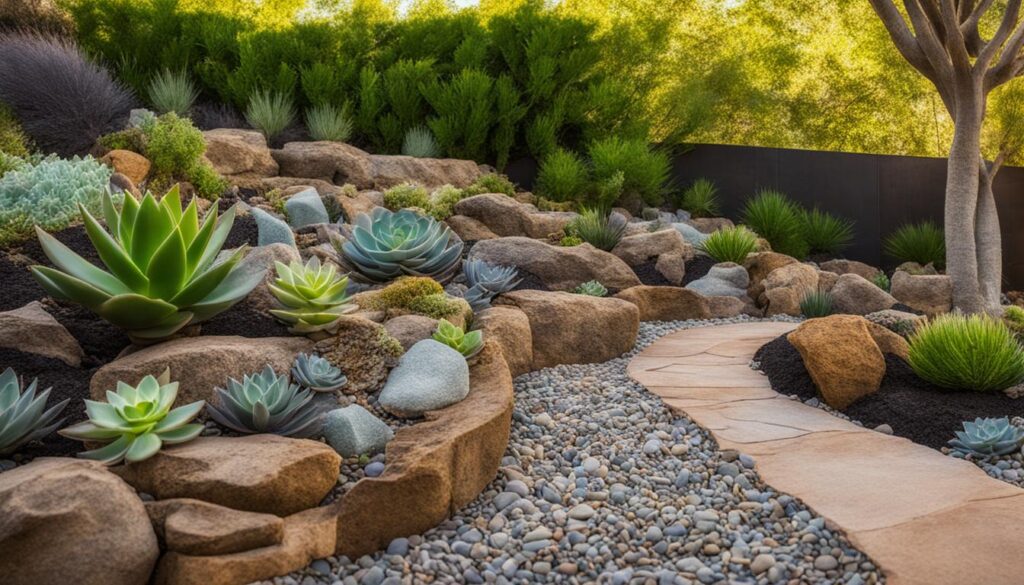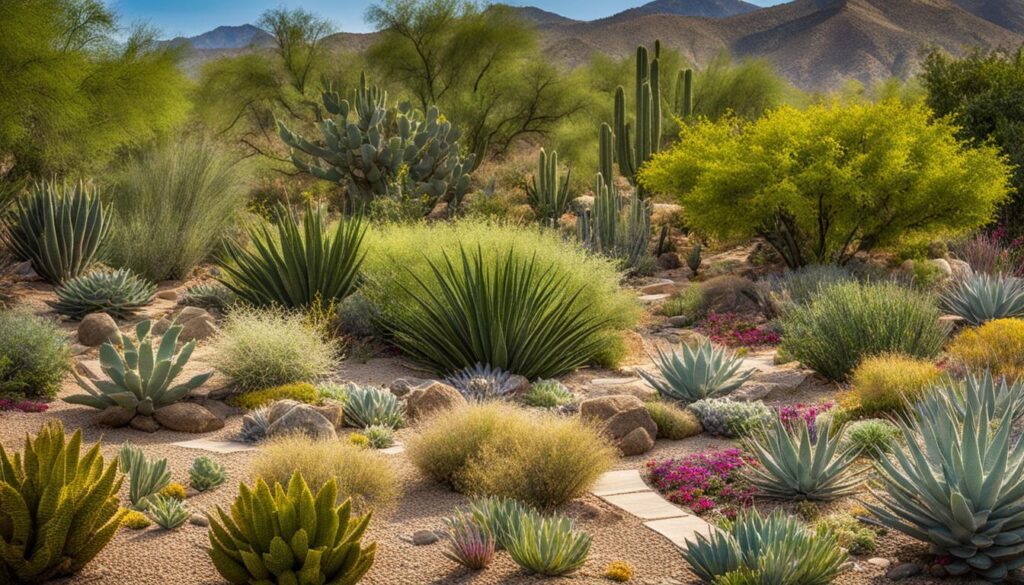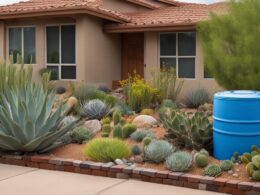Xeriscaping is a sustainable landscaping method that conserves water and promotes the use of drought-resistant plants. In this guide, we will provide you with an overview of xeriscaping principles, ideas, benefits, and essential materials. We will also compare different mulch materials commonly used in xeriscaping, helping you make an informed decision for your water-wise garden.
Key Takeaways:
- Xeriscaping is a landscaping method that conserves water and promotes sustainable practices.
- Choosing the right mulch material is crucial for water conservation and maintaining a low-maintenance garden.
- By implementing xeriscaping principles, you can create a beautiful and eco-friendly landscape.
- Xeriscaping reduces water consumption and creates a welcoming habitat for wildlife.
- Consider factors like moisture retention, weed control, and longevity when comparing mulch materials.
Understanding Xeriscaping
Xeriscaping is a landscaping method specifically designed to minimize water usage while maintaining a beautiful and sustainable garden. By implementing strategic plant selection, improving soil quality, and utilizing appropriate irrigation methods, xeriscaping allows you to create a water-wise landscape that is both environmentally friendly and visually appealing.
Originating in Denver, Colorado, in the 1970s, xeriscaping has become increasingly popular in arid regions where water scarcity is a significant concern. The key principle behind xeriscaping is to select plants that are drought-resistant and can thrive in the local climate conditions. By doing so, you can significantly reduce water consumption and create a more sustainable outdoor space.
In addition to strategic plant selection, xeriscaping also emphasizes soil improvement. By incorporating organic matter into the soil, you can enhance its structure and fertility, allowing it to retain moisture more effectively. This helps to minimize the need for excessive watering and contributes to overall water conservation efforts.
Appropriate irrigation methods are another crucial aspect of xeriscaping. Drip irrigation and soaker hoses are commonly used in xeriscaped gardens as they deliver water directly to the roots of plants, minimizing water waste caused by evaporation or runoff. These methods ensure that water is utilized efficiently, further reducing water usage and promoting sustainable gardening practices.
Benefits of Xeriscaping:
- Conserves water by up to 70-80% compared to traditional lawns and gardens.
- Reduces maintenance needs, saving time and effort.
- Results in cost savings due to lower water consumption and reduced maintenance requirements.
- Creates a welcoming habitat for local wildlife and essential pollinators.
Table: Mulch Materials Comparison
| Mulch Material | Benefits | Drawbacks |
|---|---|---|
| Rubber Mulch | Retains moisture efficiently, reduces weed growth, made from recycled tires. | May release chemicals, higher cost compared to other materials. |
| Wood Chips | Provides natural aesthetics, improves soil health. | May require regular replenishment. |
| Gravel | Allows for better drainage, long-lasting. | Can increase soil temperature. |
The Benefits of Xeriscaping
Xeriscaping offers numerous benefits for homeowners and the environment. By implementing this sustainable landscaping method, you can enjoy the following advantages:
- Water Conservation: Xeriscaping significantly reduces water consumption compared to traditional lawns and gardens. With proper plant selection, soil improvement, and efficient irrigation methods, you can decrease water usage by up to 70-80%. This not only saves water but also helps address the increasing demand for water in arid regions.
- Low Maintenance: Xeriscaping requires less maintenance compared to traditional landscapes. With the use of drought-resistant plants and mulch materials, you can minimize the need for mowing, watering, and fertilizing. This not only saves time and effort but also reduces the use of chemicals and machinery, contributing to a healthier environment.
- Financial Savings: By conserving water and reducing maintenance needs, xeriscaping can lead to significant cost savings. With lower water bills and less expenditure on lawn care products and equipment, you can enjoy financial benefits while still having a beautiful and sustainable landscape.
- Wildlife Habitat: Xeriscaped gardens provide a welcoming habitat for local wildlife, including birds, butterflies, and beneficial insects. The use of native plants in xeriscaping attracts and supports these species, creating a balanced ecosystem and promoting biodiversity. By nurturing wildlife habitats, you contribute to the conservation of precious natural resources.
With its focus on water conservation, low maintenance, financial savings, and the creation of wildlife habitats, xeriscaping offers a holistic approach to sustainable landscaping. By embracing xeriscaping principles, you can create a beautiful, environmentally friendly outdoor space that benefits both you and the planet.
Quote:
“Xeriscaping allows homeowners to have gorgeous gardens while also conserving water and supporting local wildlife. It’s a win-win situation for both aesthetics and sustainability.” – Landscaping expert
Table: Comparison of Xeriscaping Benefits
| Benefits | Water Conservation | Low Maintenance | Financial Savings | Wildlife Habitat |
|---|---|---|---|---|
| Description | Reduces water consumption by 70-80% | Requires less mowing, watering, and fertilizing | Lowers water bills and reduces maintenance costs | Attracts and supports local wildlife |
| Advantages | – Addresses water scarcity – Helps save money on water bills |
– Saves time and effort – Reduces the use of chemicals and machinery |
– Decreases expenditure on lawn care products and equipment | – Promotes biodiversity and conservation – Creates a balanced ecosystem |
Table: Comparison of xeriscaping benefits including water conservation, low maintenance, financial savings, and wildlife habitat.
Getting Started with Xeriscaping
When it comes to creating a water-wise and sustainable garden, getting started with xeriscaping is the first step. This landscaping method not only conserves water but also promotes the use of native and drought-resistant plants, improves soil quality, and minimizes water waste through efficient irrigation. Follow these essential steps to begin your xeriscaping journey:
Evaluating Your Landscape
Before diving into xeriscaping, take the time to evaluate your landscape. Consider factors such as sunlight and shade patterns, soil type, drainage, and the existing plants in your garden. Understanding these elements will help you make informed decisions when selecting plants and determining the best irrigation methods for your specific landscape.
Choosing Native and Drought-Resistant Plants
Xeriscaping emphasizes the use of plants that are well-suited to your region’s climate. Native and drought-resistant plants have evolved to survive with minimal water, making them ideal choices for a water-wise garden. Research and select plants that are known to thrive in your area without excessive irrigation needs. This will help conserve water and ensure the longevity of your garden.
Improving Soil Structure and Fertility
Preparing the soil is crucial for the success of your xeriscaped garden. Incorporate organic matter such as compost or well-rotted manure to improve soil structure, fertility, and moisture-retention. Adding organic matter increases the soil’s ability to hold water, reducing the need for frequent watering. It also promotes beneficial microbial activity, enhancing plant growth and overall garden health.
Setting Up an Efficient Irrigation System
Efficient irrigation is essential in xeriscaping to minimize water waste. Consider using methods such as drip irrigation or soaker hoses to deliver water directly to the roots of plants, reducing evaporation and ensuring water reaches where it is needed most. These systems allow for precise control over watering, preventing overwatering and promoting plant health. Install a timer or moisture sensor to further optimize water usage and ensure your garden stays hydrated without unnecessary water loss.
By following these steps and adopting xeriscaping principles, you can create a beautiful, water-wise garden that thrives while conserving precious resources.
Comparison of Xeriscaping Mulch Materials
Xeriscaping is all about making smart choices when it comes to conserving water and creating a sustainable landscape. One important aspect of xeriscaping is choosing the right mulch material for your garden. In this section, we will compare three commonly used mulch materials in xeriscaping: rubber mulch, wood chips, and gravel. Let’s explore the benefits and drawbacks of each option to help you make an informed decision for your water-wise garden.
The Benefits of Rubber Mulch
Rubber mulch is a popular choice for xeriscaping due to its unique properties. Made from recycled tires, rubber mulch is an eco-friendly option that effectively retains moisture in the soil, reducing the need for frequent watering. Its ability to suppress weed growth can also save you time and effort in maintaining your garden. Additionally, rubber mulch does not decompose, making it a long-lasting option that doesn’t require regular replenishment. Its durability also makes it an excellent choice for areas with high foot traffic.
The Advantages of Wood Chips
Wood chips offer both aesthetic appeal and practical benefits in xeriscaping. They provide a natural and organic look to your garden, blending seamlessly with the surrounding landscape. Wood chips also help improve soil health by retaining moisture, regulating soil temperature, and reducing erosion. As they break down over time, they contribute to the organic matter in the soil, enhancing its fertility. However, it’s important to note that wood chips may require periodic replenishment as they decompose and break down.
The Benefits and Drawbacks of Gravel
Gravel is a versatile mulch material that offers unique advantages in xeriscaping. Its permeability allows for excellent drainage, preventing water from accumulating around plant roots and potentially causing rot. Gravel also helps to reflect sunlight, reducing soil temperature and minimizing evaporation. Additionally, its long-lasting nature means less maintenance and replacement compared to other mulch materials. However, it’s worth considering that gravel can increase soil temperature in hotter climates, potentially affecting plant health.
| Mulch Material | Benefits | Drawbacks |
|---|---|---|
| Rubber Mulch | Retains moisture, reduces weed growth, made from recycled tires | Does not decompose, may be less aesthetically appealing |
| Wood Chips | Natural aesthetics, improves soil health, regulates moisture | May require periodic replenishment as it decomposes |
| Gravel | Excellent drainage, reduces soil temperature, long-lasting | Increases soil temperature in hotter climates |
When choosing a mulch material for your xeriscaped garden, consider factors such as moisture retention, weed control, aesthetic appeal, and long-term maintenance. Each material has its own set of benefits and drawbacks, so weigh your options based on your specific needs and preferences. By selecting the right mulch material, you can enhance the beauty of your landscape while conserving water and promoting sustainability.
Which Mulch Options Are Best for Xeriscaping?
When it comes to xeriscaping, colorful mulch options for xeriscaping can add visual interest while conserving water. Consider using options like red cedar, pine straw, or rubber mulch to enhance the aesthetic of your xeriscaped garden. These options not only look great but also help in water conservation.
Conclusion
Xeriscaping is an excellent choice for creating a sustainable and eco-friendly garden that promotes water conservation. By implementing xeriscaping principles, such as strategic plant selection, soil improvement, and efficient irrigation methods, you can transform your outdoor space into a beautiful and water-wise landscape.
When it comes to choosing mulch materials for your xeriscaped garden, consider factors such as moisture retention, weed control, and longevity. There are various options available, including rubber mulch, wood chips, and gravel, each with its own benefits and drawbacks. Select the material that best suits your specific needs and preferences.
Remember, xeriscaping not only helps you save water and maintain a low-maintenance garden but also contributes to preserving the environment. By embracing sustainable gardening practices, you can create a beautiful outdoor space while minimizing your impact on natural resources. Start your xeriscaping journey today and enjoy the benefits of a sustainable, water-conserving, and eco-friendly landscape.











